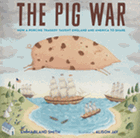
"The pig was British. Or at least its owner was." Emma Bland Smith's The Pig War is a funny explanation of a little-known event in American history: in 1859, one small pig caused a Cold War-like standoff between British and American forces.
On the Pacific Northwest island of San Juan, Americans and Brits lived in relative peace, "if not exactly friends, then at least polite rivals." One day, American farmer Lyman Cutlar spotted a British-owned pig in his potato patch. Lyman's temper got the best of him and he killed the pig, only to immediately regret his rash decision. When he tried to pay his British neighbor, Charles Griffin, for the pig, Charles requested an outrageous sum and the two began to argue about to whom the island belonged. One pig's death quickly spiraled into an international incident. As the months went by and troops gathered on both sides, everyone wondered if the two countries were heading for another war. Nobody wanted to fight, but is there another option when two nations both lay claim to a land?
Alison Jay (A Lady Has the Floor) uses alkyd paint on paper with a crackle glaze varnish to give each illustration an old-timey feel; her colorful, folk-art style brings to life the various (often hot-headed) figures in the story. Bland Smith (Journey) delicately balances the absurd humor of the situation with the seriousness of the potential for yet another British-American war. An author's note with pictures, a timeline and a list of sources make this picture book both an entertaining read and useful resource for young historians. --Kyla Paterno, freelance reviewer

